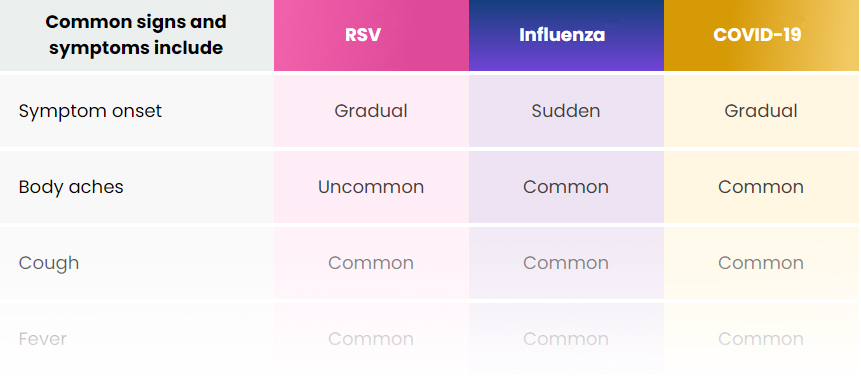
Explore our corporate partner AstraZeneca’s new one-stop web resource for respiratory virus knowledge and try the symptom comparator right away.

© AstraZeneca
It’s that time of year again when coughs and colds are ubiquitous. But is it possible to have several respiratory diseases at the same time?
Indeed, this phenomenon is known as coinfection although it is relatively rare due to the competition between the viruses during infection.[1-3]
While infrequent, the consequences of coinfection may be severe:
For instance, studies have shown that patients in the UK who experienced a coinfection of COVID-19 and influenza were twice as likely to die as those with COVID-19 alone.[4]
Similarly, a South African study conducted in 2017 demonstrated that individuals coinfected with RSV and influenza, as opposed to those with influenza alone, faced heightened odds of developing life-threatening conditions and requiring prolonged hospital stays.[5]
A third study unveiled that children under 18 years of age in the US who were co-infected with COVID-19 and influenza, rather than having influenza alone, were at a higher risk of requiring ventilator support.[6]
That is why it is so important to know the facts and distinguish the distinctive signs and symptoms of the different respiratory viruses. A new symptom comparator tool helps to differentiate between the common symptoms of RSV, influenza and COVID-19 and sorts their occurrence by frequency:

© AstraZeneca
If you would like to view and test the entire symptom comparator, please click here.
At KnowVirusFacts.com you can also find fast facts about the
- manifestations of the virus,
- seasonality,
- risks and
- links for virus surveillance data,
all in one place.
References:
- Influenza (Flu): Frequently asked influenza (flu) questions: 2022-2023 Season. Centers for Disease Control and Prevention. Updated November 21, 2022. Accessed July 7, 2023. https://www.cdc.gov/flu/season/faq-flu-season-2022-2023.htm
- Respiratory Syncytial Virus Infection (RSV): Symptoms and care. Centers for Disease Control and Prevention. Updated September 6, 2023. Accessed September 12, 2023. https://www.cdc.gov/rsv/about/symptoms.html
- Older adults are at high risk for severe RSV infection. Centers for Disease Control and Prevention. Published April 2023. Accessed July 7, 2023. https://www.cdc.gov/rsv/factsheet-older-adults.pdf
- Stowe J, Tessier E, Zhao H, et al. Interactions between SARS-CoV-2 and influenza, and the impact of coinfection on disease severity: a test-negative design. Int J Epidemiol.2021;50(4):1124-1133. doi:10.1093/ije/dyab081
- Mazur NI, Bont L, Cohen AL, et al. Severity of respiratory syncytial virus lower respiratory tract infection with viral coinfection in HIV-uninfected children. Clin Infect Dis.2017;64(4):443-450. doi:10.1093/cid/ciw756
- Adams K, Tastad KJ, Huang S, et al. Prevalence of SARS-CoV-2 and influenza coinfection and clinical characteristics among children and adolescents aged <18 years who were hospitalized or died with influenza—United States, 2021-22 influenza season. MMWR Morb Mortal Wkly Rep.2022;71(50):1589-1596. doi:10.15585/mmwr.mm7150a4

